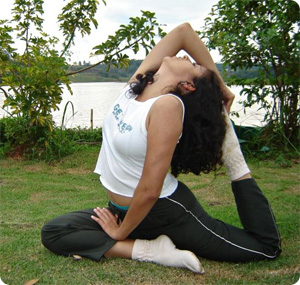Raja Yoga

An important branch of Yoga, Raja Yoga is a one stop solution for
complete and holistic healing. Raja Yoga possesses the positive
power of influencing the life of human beings. Apart from
harmonizing with all spheres the physiological system, it also
transforms the physical, mental, emotional, intellectual,
occupational, social and spiritual being of a person. Raja Yoga also
helps an individual to alleviate himself/herself from all emotional
and mental conflicts. It brings lasting peace and satisfaction in
one's life. One of the most prominent benefits of Raj Yoga is that
it heals a person from the inside. However, the benefit of Raj Yoga
is not just limited to the mind and body of a person, but it also
brings harmony with other human beings and environment, at large.
Raja Yoga is sometimes referred as Astanga or eight-limbed yoga.
This is because there are eight aspects to the path to which one
must attend. To know more about the eight limbs of Astanga Yoga,
read through the following lines.
The Eight Limbs Of Astanga Yoga
Yama
Yama is the first limb of Ashtanga Yoga and comprises of the
behavioral norms that need to be followed, to attain tranquility of
the mind. It mainly comprises of directives such as Ahimsa
(non-violence), Satya (truthfulness), Asteya (non-stealing),
Brahmacharya (celibacy) and Aparigraha (non-covetousness). These are
essential for eradicating the element of fear and anger from the
body.
Niyama
Niyama controls the emotional aspect of a person, with the help of
mental exercises to train the mind. Its directives involve Shaucha
(internal and external purity), Santosha (contentment), Tapas
(austerity), Svadhyaya (study of religious books and repetitions of
Mantras) and Ishvarapranidhana (self-surrender to God, and His
worship).
Asana
Asan or posture is a means to attain integration of mind and body,
by means of physical activity. Contrary to the popular belief,
asanas are not exercise, but activities which help to transmit the
positive energies to the crown chakra. Apart from providing numerous
physical health benefits, the various asanas aim to bring unison of
the mind and the body with the spirit.
Pranayama
Just as the name suggests, (prana, which means life energy and yama,
which signifies control), pranayama is a way by which one can attain
life force energy control, through breathing. The main goal of
pranayama heads towards the awakening of the kundalini shakti at the
muladhara chakra. It is through breathing regulation that one can
attain control over the life energies.
Pratyahara
Once the above four limbs have been achieved, Pratyahara aims to
attain the withdrawal of the senses of perception from their
objects. It should not be linked to be the same as that of
concentration or meditation. Instead, it aims to bring the awareness
to reside deep within oneself, free from the senses and external
world.
Dharana
Dharana focuses on concentration and one-pointedness of the mind.
For attaining an ideal concentration level, you need to follow the
factors such as retention of breath, Brahmacharya, Satvic (pure)
food, seclusion, silence, Satsanga (being in the company of a guru),
and not mixing much with people. Concentration on Trikuti (the space
between the two eyebrows) would help to control the mind.
Dhyana
Dhyana focuses on the importance of meditation. The basic of this
limb is to involve oneself in quiet activity that will help you
leads to Samadhi. Social exclusion, less talk, no demands, no
violence and limited eating and sleeping all contribute to Dhyana.
Samadhi
Samadhi can be described as enlightenment. To attain Samadhi, you
need to remove obstacles which come as Avidya (ignorance), Asmita
(egoism), Raga-Dvesha (likes and dislikes), Abhinivesha (clinging to
mundane life).
| |
Other Categories
Bhakti Yoga
Hatha Yoga
Jnana Yoga
Karma Yoga
Kundalini Yoga
Mantra Yoga
Purna Yoga
Raja Yoga
Main Categories
What is Yoga
Yoga Tips
Yoga Poses
Yoga Types
Yoga Benefits
Limbs of Yoga
Yoga Gear Guide
Yoga Readings
Yoga in West
Bikram Yoga
|

